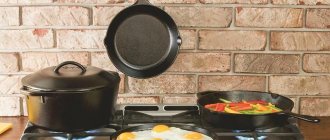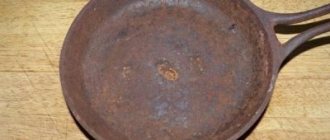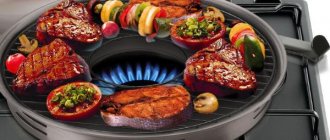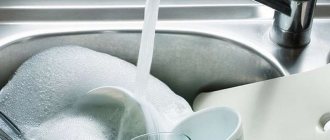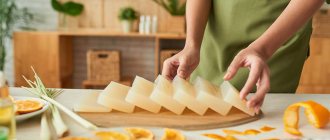Glass ceramic hob - beautiful, durable, functional. Many housewives dream of installing such a stove in the kitchen, but the question arises: what kind of cookware is suitable for use on a modern appliance? Can I keep my old pans and pots for cooking, or will I have to replace all the kitchen utensils when I buy a new stove?
The answer is clear: choosing the wrong set of dishes can lead to dire consequences. Indelible stains will appear on the panel, cooking time will increase due to poor heating, scratches and various damage will appear on the surface of the burners.
Glass ceramic cookware: which one is suitable?
Glass ceramic cookware must meet a number of requirements.
Materials
Pots with an enamel coating are recommended for use in one case: if they are equipped with special markings.
Bottom
Required diameter
Can I use enamel cookware?
Pots, ladles, and stewpans coated with enamel can be used only in one case: if they are marked “For glass-ceramic, induction panels.”
What can happen if you choose the wrong kitchen utensils
The wrong choice can lead to a number of problems:
- Electricity consumption will increase significantly if the bottom of the container does not fit tightly to the burner. To cook food, you will have to spend a lot of time, because heating will occur slowly and unevenly.
- Roughness and scratches on the cookware can lead to serious damage to the unit, including cracks on the hob.
- If the diameter of the vessel is too large, it will not allow the dish to cook evenly; if the diameter is too small, the device will not work, and the stove simply will not turn on.
- Utensils made from materials without magnetic properties are not suitable for stoves with induction coils; the stove will not work.
- Heat-resistant glass containers have low thermal conductivity, which means cooking food will take too long.
Types and features of the hob
Glass ceramic cookware is different from regular cookware because this electric cooker has certain features. There are two types of glass ceramic hob:
- with ordinary heating elements;
- with induction coil.
The peculiarity of this hob is the method of transferring heat from the heating device to the kitchen utensils. The better the contact between the surfaces, the better the heat transfer. Using the heating surface, heat is transferred from the panel to the surface of the pan. For slabs made of such material, special dishes are needed. This means that woks, cauldrons, utensils with a round bottom and similar items are not recommended for use on glass ceramics.
When choosing which cookware to use, you should pay attention to heat transfer. It follows from this that when faced with choosing which cookware to use, you should start from the type of hob. For a glass-ceramic hob, use kitchen utensils whose bottom is in maximum contact with the hob. If there is an air gap between the panel and the bottom of the kitchen utensil, like a cauldron or other kitchen utensil with a rounded bottom, heating the food takes a very long time.
If the heating element is induction, the magnetic properties of the selected containers are important. Some types of heating elements are equipped with sensors and if you use unsuitable cookware, the heating will not even turn on. The bottom of the dish must have magnetic properties. Only in this case will the induction heating element work correctly and bring maximum benefit. Heating elements with heating elements do not have such features.
Features of glass-ceramic hob
Panels with this type of coating refer to electrical appliances equipped with automation and various types of burners. The surface is perfectly smooth, made of a special material - ceran, which is resistant to deformation and can withstand high temperatures.
The heat from the burners located under the panel flows vertically, only the burners heat up. The rest of the surface remains cold, which significantly saves energy.
Glass ceramics heats up and cools down quickly.
Based on the type of burner, there are halogen, rapid, belt (hi light), and induction panels. Combination stoves are produced, which can have different types of burners, for example, two halogen and rapid burners.
Which dishes are not suitable?
Do not use cookware on a glass-ceramic hob that was previously used on a gas burner. Uneven bottoms of these pots and pans can damage the coating. There may be stains on the hob that cannot be removed. In addition to old dishes, it is also prohibited to use the following types:
- Pots with rough or damaged bottoms.
- Frying pans with welded seams or patched damage.
- Do not use aluminum cookware made of copper, brass or ceramics. These materials leave stains on the surface of the hob that cannot be removed.
- It is not recommended to use heat-resistant glass containers. The surface of the heating element will take too long to transfer heat. Thus, energy consumption increases.
It is important to choose the size of kitchen utensils for a glass-ceramic hob and match it with the diameter of the heating part of the panel. It is not recommended to use containers whose diameter is smaller than the hob. Such pans and pots are not suitable as there is a possibility that the glass-ceramic hob will overheat. You can use enamel cookware, but only if the bottom is smooth.
Is it possible to use cast iron cookware on glass ceramics?
General information Glass-ceramic coated stoves are a type of electric stove. These stoves differ from electric stoves in having a smooth mirror surface on which the burners are simply marked. The burners on such stoves begin to heat up instantly. The heat from the hot spiral passes through the glass without hindrance and heats the dishes. Glass-ceramic electric stoves are not cheap, but they are much more economical than electric stoves. Almost half of the cost goes to the ceran material from which the hob is made. This material is quite durable and will withstand even an accidental drop of a pot of soup onto the panel. However, if you really want to, you can still break the glass-ceramic panel.
According to the principle of operation, a glass-ceramic stove is similar to a cast-iron burner. Just like in the latter, the heating element serves as the transmission link. It heats up very quickly and cools down quickly, and also conducts heat well in a given direction, i.e. to the pan. A minute or two after turning it off, you can touch such a stove without fear of getting burned. Thanks to its stylish design, the glass-ceramic stove will easily fit into the interior of a modern kitchen, and fast spot heating and uniform energy distribution allows you to cook quickly and tasty.
Despite the fact that the tips and recommendations are so extensive, glass ceramics are not only beautiful, but also very convenient. Believe me, if we wrote about an enamel hob and “pancake” burners, then tips and recommendations would take up no less space. After all, the description takes into account all theoretically possible situations, most of which will never happen to your stove personally.
The special value of glass ceramics lies in its thermal conductivity properties. - it conducts heat well vertically and comparatively worse horizontally, so electricity heats the bottom of the pan to a greater extent and the space of the stove to a lesser extent. By reducing heat losses, the efficiency of the stove increased. — glass ceramics cools quickly, that is, it has low inertia. That is why now, when reducing the power on the rotary switch, very little time passes before the temperature on the surface of the burner actually decreases. Previously, this was only possible on a gas stove. — burners can now change the heating zone. And perhaps this is precisely on the flat surface of glass ceramics. After all, now you can place (not simultaneously, of course) dishes with different bottom diameters on the same burner, which, in turn, leads to careful and justified energy consumption. — the burner can now change not only its size, but also its shape. It is possible to cook in oval pans made of heat-resistant glass, duckling pans and casserole dishes. - its smooth matte surface gives kitchens a more noble and neat look. And you don’t need to lift heavy pots, you just need to move them. — some burners are equipped with automatic boiling. This significantly reduces the need for your presence in the kitchen. You immediately set the burner to a low power and turn on the automatic boiling. In this case, heating begins with maximum power, and upon reaching it, it automatically switches to the value specified by you. — burners may have an automatic heating reduction system. The stove itself monitors the heating power. You just need to program it once, and then it will automatically reduce the heating when needed. This feature is convenient if you often cook the same dish in the same quantity. — glass-ceramic ovens are equipped with lighting, temperature indicator and ventilation, electric grill and catalytic cleaning system, etc. High-end stoves are equipped, in addition to all of the above, with a microwave section. In addition, the automation of these stoves is very advanced; they can cook on their own, although they need a program for this. There are more and more glass-ceramic slabs, they are gradually replacing enameled surfaces and occupying new spaces. Now they prefer to make gas panels glass-ceramic or simply glass. Gas glass-ceramic stoves appear on sale. Therefore, the issues of caring for glass ceramics will not lose their urgency.
Dishes
Get ready for the fact that along with a new stove you will need to buy new dishes. The requirements for cookware for glass-ceramic stoves are a flat bottom without potholes or bends, ensuring full contact with the heating panel. The result is uniform heating with minimal heat loss. It is important that the bottom of pots and pans matches the diameter of the burner. The desire to comply with this condition can be seen in the instructions for the stove of almost all manufacturers. Particularly bold manufacturers claim the possibility of using aluminum and copper pans, but others have a negative attitude towards this. Maybe the first ones are connected with sellers of aluminum and copper cookware? It should be noted that high-quality cookware always has a smooth and thick bottom. In this regard, pans that were used on gas stoves are not suitable for glass ceramics. Due to uneven heating by the flame, the bottom of such a cookware will resemble a rocky area. All high-quality cookware always indicates what surfaces it is intended for—“glass ceramics.” The inscription “for electric stoves” does not suit us, because... in this case we are talking about enamel working panels (the “pancakes” that are well known to us). Enameled cookware is suitable for cooking, but you must remember that it should not be left empty on a hot burner that is turned on. The result may be damage to the surface of the glass ceramics, which can only be eliminated by completely replacing the surface itself. It is undesirable for it to have a metallic mirror shine, as this reflects heat radiation and increases cooking time. Dishes with a matte or dark bottom are best. Heat-resistant glassware takes a long time to heat up, and it is difficult to turn down the heat quickly, so it is also inconvenient to use. The bottom of the cookware should be slightly concave, because when hot, the bottom expands and then fits tightly to the surface of the stove, which allows optimal use of heating energy. Stainless steel or steel enamel cookware allows for optimal results.
Which dishes are less suitable?
Glass ceramic cookware because it conducts heat poorly; pans with a copper or aluminum bottom, because it leaves marks that are difficult to remove. Be careful when using cookware with aluminum bottoms. If traces are not removed immediately after cooking using special cleaning products, they can burn on the surface and ruin the appearance of the stove.
Care
Caring for glass ceramics is not a particular problem - there are many products sold in stores. Most special cleaning products are made in Europe (some products are produced under the brands of the stove manufacturers themselves, but there is not much difference in the contents) and are not cheap at all. All European products are highly effective and economical in consumption. Many cleaning products contain special polymer additives to prevent sticking. Along with the undeniable advantages, any glass-ceramic hob also has its disadvantages (as well as any equipment)
What glass ceramics are afraid of:
- does not like sweets - the ingestion of sugar can lead to disastrous results; aluminum and plastic cannot be tolerated at all - you cannot clean the glass-ceramic stove using metal sponges, knives, brushes and other sharp devices (a pleasant exception among sharp objects is special retractable scrapers) - it is strictly forbidden to clean surface with abrasive means - is afraid of pinpoint impacts, can withstand a pan weighing 10 kg, but can easily crack as a result of an accidental fall of a heavy lid or a sharp object (knives, forks, spoons) - do not allow water to come into contact with a hot burner (especially splashes of cold water) - It is not recommended to place a wet pan on a burner that has not yet cooled down - if liquid gets on a burner that has not yet cooled down, the chances that the panel in this place may crack over time are very high - do not use lint cloths or dishwashing sponges for cleaning
How to clean and care for glass ceramics:
First, remove any remaining food with a scraper (it is advisable to do this on a slightly warm surface). When the surface has completely cooled, apply a little cleaner to the stove and rub with a paper towel. You can use a clean, soft, lint-free cloth. Recently, special cleaning wipes for glass ceramics have become especially popular. Next, wipe with a damp towel and polish to a shine with a dry, clean towel. Burnt sugar, melted plastic, aluminum foil and other fusible materials should be removed immediately while they are still hot using a scraper. Then clean the cooled cooking zone as usual. If the burner with melted materials has already cooled down, before starting cleaning, heat it up again by turning the heat switch to two. We clean with extreme caution - do not wipe the surface with a dishwashing sponge, because... Behind the apparent cleanliness, traces of fat or detergent will certainly remain on the surface as a thin smeared film, which will certainly burn the next time you turn it on and lead to extremely unpleasant discoloration of the surface and the appearance of nasty stains. Traces of lime and water, splashes of grease and stains with a metallic sheen (by the way, a very common problem) that change the color of the surface should be removed using conventional glass ceramic cleaning products. For particularly strong stains, use cleaning agents for high-quality steel products (before cleaning, check the product for abrasive content). We recommend using stainless steel cleaning products in the form of special foam from well-known manufacturers. Detergents must not come into contact with the hot glass ceramic hob! After cleaning, rinse off detergents completely with clean water. If you do not want to get blue stains on the stove, do not use dishwashing detergent for cleaning. These stains hopelessly spoil the appearance of the slab and are almost impossible to remove even with special means. The only consolation is that they do not affect the operation of the panel. The use of sponges and steel wool is not allowed. Do not use plastic or aluminum foil on the glass-ceramic surface. In addition, you should be careful not to get sugar and sugar-containing liquids (jam, compotes, juices, etc.) on glass ceramics. If these substances come into contact with the glass-ceramic surface, they must be immediately removed from the surface using a scraper. If food escapes, it should be immediately removed from the hot heating zone and the remains removed using a scraper. A scraper is necessary to completely remove hot food that has escaped, especially food containing sugar. After the stove has cooled down, it should be cleaned using a special cleaning agent using a paper napkin. Finally, it is wiped with a damp cloth and wiped dry.
Possible damage
Scratches, sinkholes, stains and discoloration of the decor. They only spoil the appearance. The surface of the stove can still be used for cooking. But if the working surface of the stove breaks, cracks appear, or technical problems arise, you should immediately contact the manufacturer’s service department. Attention! The user's safety can no longer be guaranteed in such cases.
What else is glass ceramics afraid of?
Glass ceramics are resistant to mechanical stress and can withstand heavy loads, but are susceptible to pinpoint impacts, for example, a crack can appear as a result of a knife falling with the blade down. In practice, such a fall is extremely rare, but theoretically it is quite possible. Do not splash cold water on a hot burner and try not to place a cold and wet pan on a hot burner that has not yet cooled down. Most likely nothing bad will happen, but sooner or later the coating may fail. If the liquid that “escaped” from the pan on one burner gets onto the adjacent burner that has not yet cooled down, the panel in this place may crack. It is not necessary that it will crack as soon as you spill liquid. But this could happen in, say, 10,001 cases. Glass ceramics love neat housewives. Do not use dirty or dry rags for cleaning. They can serve you badly, and glass ceramics after such “cleaning” will become dirtier than before. Why should the bottom of the cooking utensil be clean and dry? So that the remaining food residues on it do not burn on the surface of the stove. This will prevent scratches, defects and deposits (e.g. limescale stains) and thus complaints. The smooth surface of glass ceramics can be of poor service if a large amount of liquid is spilled on the panel. Naturally, it will flow down the walls of the stove onto the floor. It's good if it's just water, even better if it's clean. What if rich, fatty borscht spills? You will have to wash not only the glass ceramics, but also the walls of the stove and the floor around it. Another nuisance concerns not only glass-ceramic stoves. It’s not very common to find models with a heating zone of small diameter, which would fit under a cezve or a small geyser coffee maker. Lovers of coffee prepared in this way have to either violate the rules for operating the device, risking damage to the burner, or refuse to prepare their favorite drink. Another small but important note regarding all types of glass-ceramic burners: first place the cookware on the burner, and then turn on the last one. An electric stove requires a lot of power, so it requires a special grounding connection, which should only be installed by qualified electricians. Induction burners and stoves If you have induction burners on a glass-ceramic surface, then you should take the choice of pans even more seriously. Induction burners are one of the latest engineering achievements that, according to experts, are capable of making a real revolution in the production of household stoves. Their operating principle is based on the circulation of eddy currents in the bottom of a metal dish, which heat it, just as any current heats an electrical wire. That is, heat is created directly in the thickness of the bottom of the dish. A special induction unit is installed under the glass-ceramic panel, with the help of which electromagnetic radiation is generated, which, penetrating into the bottom of the cookware (it must be thick), heats it. Induction burners provide extremely fast boiling of water, and their power can be adjusted very precisely. You can cook dinner on such a stove in half the time than on a gas or conventional electric stove (including glass-ceramic). Water in a two-liter saucepan placed on such a stove will boil in 2-3 minutes. At the same time, the surface of the stove itself remains cold - only the metal bottom of the pot or pan is heated using special electromagnetic fields. This new way of cooking is absolutely harmless to health. The only condition that you must meet when purchasing such a stove is to replace the old kitchen utensils with new ones. The requirements for the cookware are as follows: it must be magnetizable (cast iron or enameled steel). In principle, you can check whether the saucepan you like fits your burner using a magnet. Pots with bottoms made of metal alloys (“sandwich”) are suitable only if specified by the cookware manufacturer. This means that the bottom contains a ferromagnetic element. For induction burners, cookware made of aluminum, copper, brass, stainless steel (unless marked), glass, ceramics and porcelain cannot be used. Glass or ceramics on such a stove will not heat up at all. Unfortunately, such a stove is not available to every housewife; its price is quite high. But in fairness, it must be said: in terms of operating efficiency and temperature accuracy, induction cookers today have no equal.
That, in principle, is all a good housewife needs to know about glass-ceramic stoves.
link
What materials are safe
Despite the existence of a large number of restrictions on the use of containers for such a panel, there are a large number of answers to the question of which dishes are suitable for glass ceramics. Glass ceramic cookware is made from different materials and has different volumes and shapes. Glass ceramic cookware is purchased together with a heating element. Knowing what kind of cookware can be used on a glass-ceramic hob, you can save your hob.
Enameled cookware
Enameled cookware can be used on this heating element. Enameled has a number of features:
- Glass ceramic dishes often do not look presentable. Enameled products have a large number of designs, shapes and colors.
- If you are using an enamel cookware, check the bottom carefully before placing the container on the stove.
- It is not advisable for the same pan to be used on a gas heating element. Otherwise, check that the bottom is even and free of dirt before each use.
Although it is allowed to use an enamel container, placing the pan on a glass-ceramic panel if it is empty is prohibited. It is necessary to monitor the presence of liquid or cooking product inside the container. Otherwise, the surface of the heating element will be seriously damaged due to heating. It becomes unsuitable for further use, and its properties are partially lost.
Use of cast iron
This cookware is suitable for cooking on induction cookers. The disadvantage of cast iron products is their large mass, which requires more energy to heat the containers. Electricity consumption increases.
Place kitchen utensils on the hob carefully. Otherwise, the metal may scratch the electrical appliance. If you place the pan too sharply, the stove may break. Since the bottom is often not very smooth, the product will not heat up instantly.
Tips for choosing
To select the right kitchen utensils, it is recommended to use a magnet, which should be placed on the bottom of the utensil when choosing. If it sticks, the container is suitable for use on an induction hob.
In addition to the above rule for an induction hob, other rules for choosing a suitable container are followed:
- Kitchen utensils must have a perfectly flat bottom. Concave, damaged shapes are not allowed.
- It is worth using kitchenware with a minimum bottom reflection coefficient. Thanks to this, the container heats up much faster, distribution occurs systematically. It is better to choose models with a dark or matte bottom. The glossy surface can reflect heat.
- The bottom must have a thickness of 3 mm. If it is thinner, the cookware runs the risk of becoming deformed during the cooking process. Models that are too thick take a long time to warm up.
- It is important to choose the correct bottom diameter. It must match the heating elements of the stove.
- When choosing aluminum containers, it is recommended to choose models with a painted or steel bottom.
- It is prohibited to use glass-ceramic containers on these stoves. In addition to the weak thermal conductivity of such an element, when using a plate and a container made of the same material together, the likelihood of scratching the surface increases.
Choosing kitchen utensils for a glass-ceramic panel is a labor-intensive and responsible task. But by choosing the right kitchen utensils, you can extend the life of the heating device. At the same time, food is prepared quickly, and energy consumption is rational.
What not to use
If we are talking about materials, then products made of copper or aluminum are completely unsuitable. When heated, they can leave marks on the surface of the glass, which are then extremely difficult to remove.
It’s better not to save money and buy new utensils for the glass-ceramic surface. Old dishes are absolutely not suitable. Even if it seems that the bottom is clean and level, it is better not to take risks. Any dirty parts, unevenness or carbon deposits can ruin the surface. Frying pans for glass-ceramic stoves must have a perfectly flat bottom.

